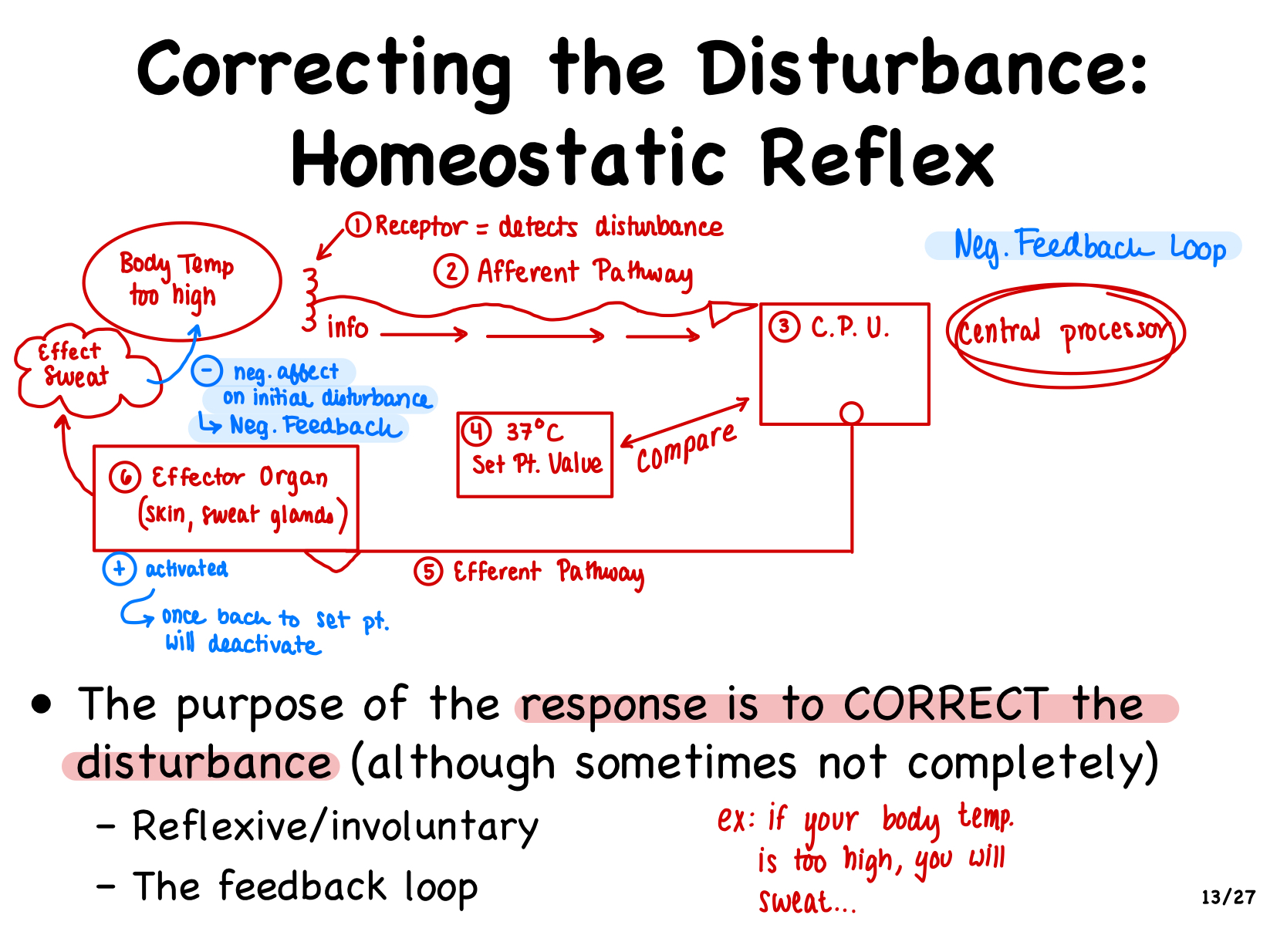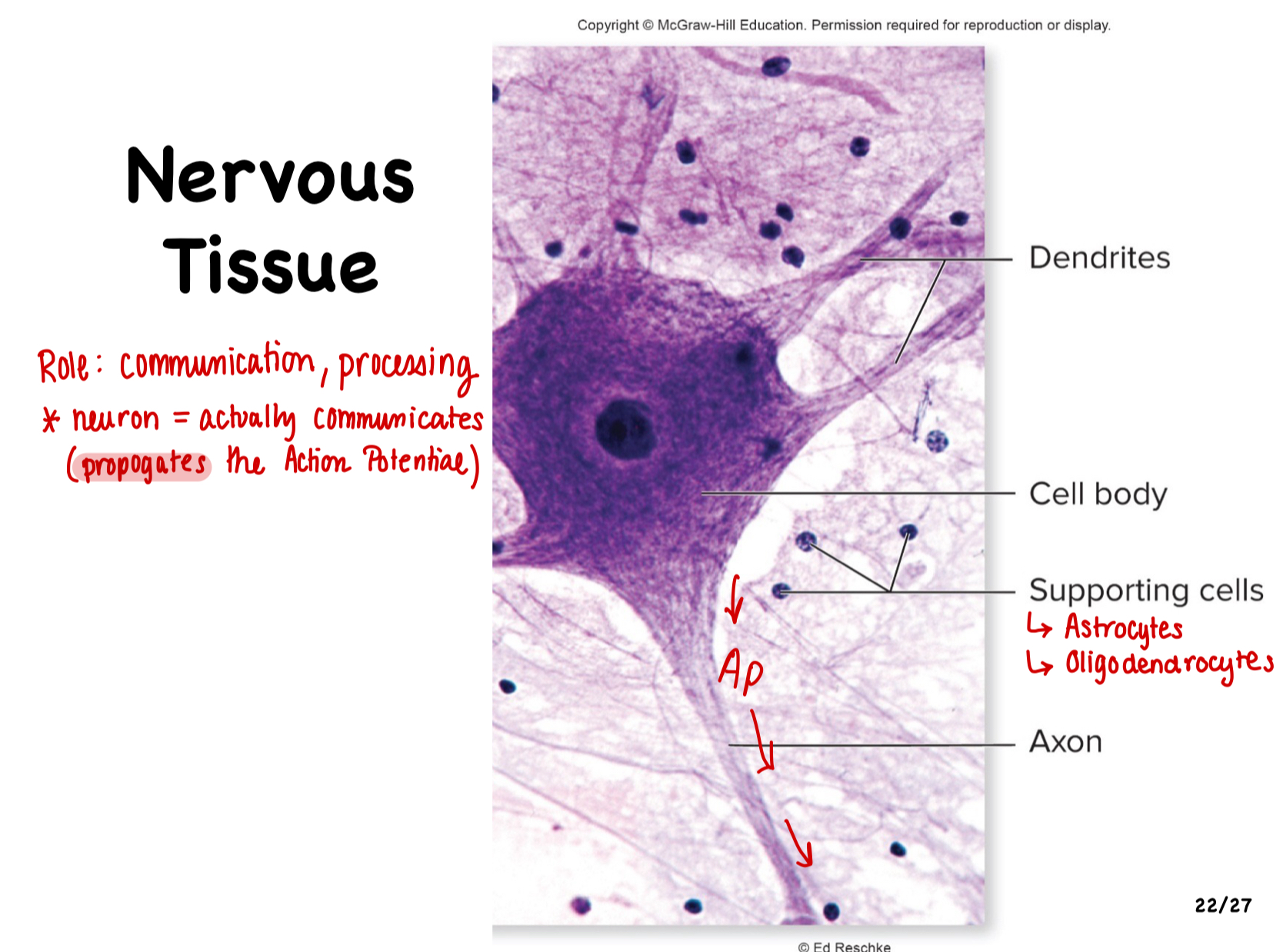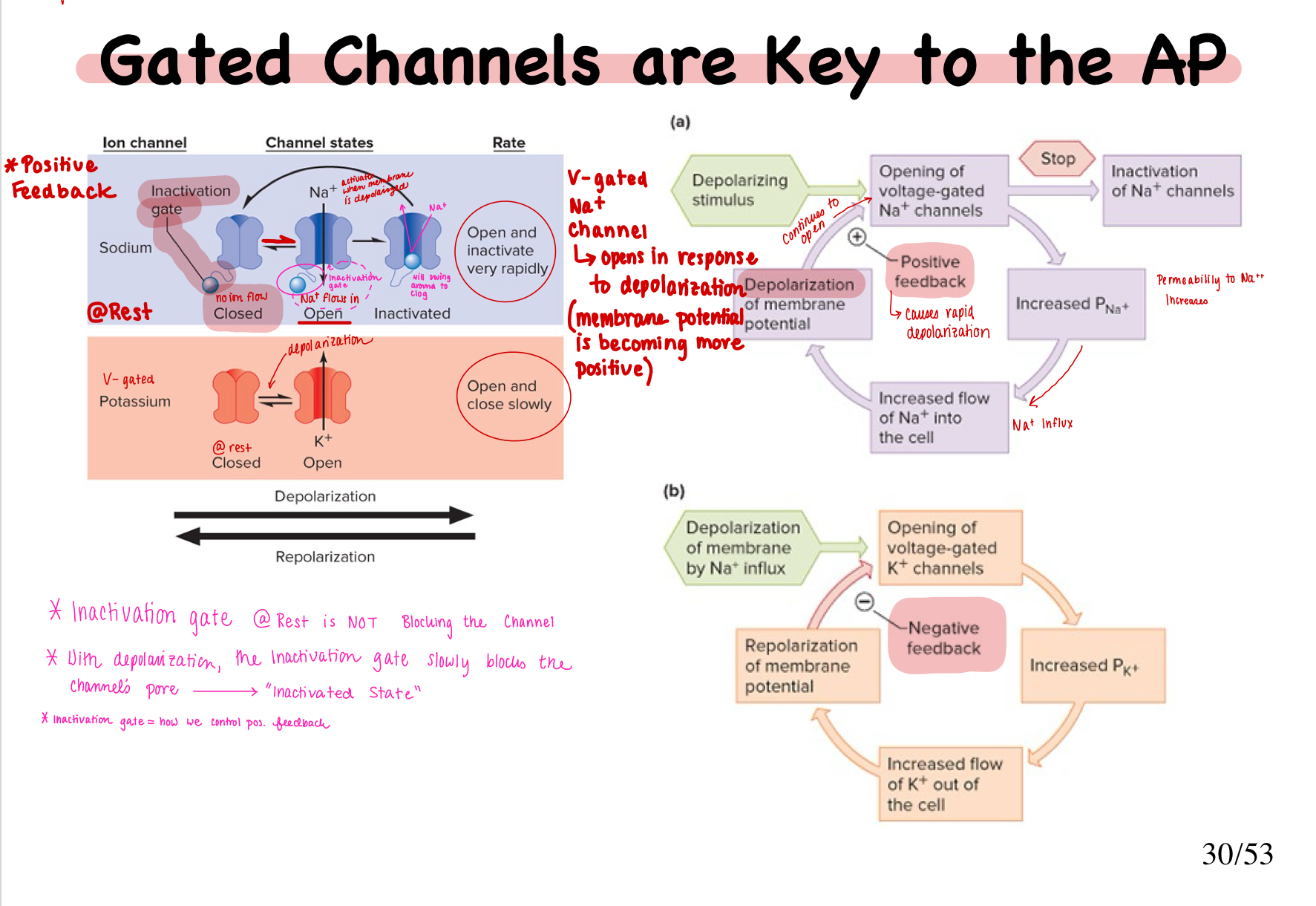NPB 101 Exam 1
1/192
There's no tags or description
Looks like no tags are added yet.
Name | Mastery | Learn | Test | Matching | Spaced |
|---|
No study sessions yet.
193 Terms
What is Physiology
An old field of study done by many intellecturals (Aristole first described functions in all living organisms, Galen of Pergamon believed that the brain controlled all living functions)…USED SCIENTIFIC METHOD (made observations, asked questions, propsed hypothetical mechanisms, used other sciences to investiagte physiology
Define Physiology
Study of Body’s Function
What is Mechanistic Approach
We propse several hypothetical mechanisms to explain body functions…each mechanism is tested experimentally
Gradients drive movement of _____
molecules
What is Homeostasis and why is it maintained?
body organs operate in order to maintain a relatively constant internal environement…it is maintained because disturbances in this internal environment can disrupt cellular function and life function
What is the internal environment
Fluid (ECF, plasma, brain)
Nearly every organ system homeostatically regulates body parameters:
Body temperature, Blood Glucose, Gas concentrains in blood, Concerntration of water, electrolytes, salt and body pH

How do you correct the disturbance, what is homeostatic reflex? Describe the image.
Negative Feedback Loop is a process that counteracts a disturbance by initiating responses that restore the internal environment to its set point.
If you have a high body temperature, your receptor will detect this disturbance and sends information to the central processor through your afferent pathway. The central processor will compare this information to your set pt. value and determine what decision to make. It then sends information to the effector organ (sweat glands) through your efferent pathway. The efferent pathway will activate the effector organ to produce sweat until your body returns to the set pt.
*it is called negative feedback because it produces a negative affect on the intital disturbance
What is the purpose of homeostasis?
to correct the disturbance (although sometimes not completely)
-reflexive/involuntary
If you are in a diseased state, the set pt. will shift…what happens?
we will homeostatically regulate to that new pt.
What is the heirarchy of body organization
chemical/molecular
cellular
tissue-level
organ-level
organ system-level
what is the primary unit of life?
cells (the human body has 37.2 to 70 trillion) (200 different types)
What is the Cell Membrane?
the cell membrane acts as a wall to separate the ECF from the ICF. Structurally, it is made of the phospholipid bilayer (the hydrophilic head (negatively charged and polar) and hydrophobic tails (uncharged and nonpolar))
What is cytoplasm
liquid portion of the cell
What is the cytoskeleton
alot of protein strands that provide shape and strength
What is an organelle and what are the two kinds?
an organelle is a little organ. the two types are the membrane bound ones (Endoplasmic Reticulum and the mitochondria) and non-membrane bound ones (ribosomes)
What are tissues made of and how many types are there?
Tissues are a collection/grouping/cluster of cells that work together…there are 4 types of tissues: muscle tissue, nervous tissue, epithelial tissue, and connecting tissue
describe muscle tissue
Role: Contraction → shorten, generate force, generate heat
Muscle Tissue (3 types)
Skeletal (skeleton)
voluntary
striated
Cardiac (heart)
involuntary
striated
Smooth (hollow organs)
involuntary
unstriated
describe nervous tissue
Role: communication, processing, neuron = actively communicates (propogates the Action Potential)

describe epithelial tissue
Role: serves as covering over organs (ex: kidney in nephron, skin)d
describe connecting tissues
adipose tissue = storage site for lipids
bone tissue
cartilage
describe organs
organs are made up of two or more tissues that work together
organs are organized into _________
organ systems
define organ systems
the group of organs perform activites that accomplish specific tasks (we have around 11-12 different organ systems)
All organ systems are involved in homeostasis except ____
Reproductive system
circulatory system
heart, blood vessels, blood
digestive system
mouth, pharynx, esophagus, stomach, small intestine, large intestine, salivary glands, exocrine pancrease, liver, gallbalder
respiratory system
nose, pharynx, larynx, trachea, bronchi, lungs
urinary system
kidneys, ureters, urinary bladder, urethra
skeletal system
bones, cartilage, joints
muscular system
skeletal system
integumentary system
skin, hair, nails
immune system
lymph nodes, thymus, bone marrow, tonsils, adenoids, spleen, appendiz, and not shown, white blood cells, gut-associated lymphoid tissue, and skin-asscoaited lymphoid tissue
nervous sytem
brain, spinal cord, peripheral nerves, and special sense organs
endocrine system
all hormone-secreting tissues, including hypothalamus, pituitary, thyroid, adrenals, endocrine pancreas, gonads, kidneys, pineal, thymus, and parathyroids, intestine, heart, skin, and adipose tissue
reproductive system
male: testes, penis, prostate gland, seminal vesciles, bulborethral glands and associated ducts
females: ovaries, oviducts, uterus, vagina, breasts
membrane proteins provide functions to membranes in two primary ways
spanning/transmembrane = span across lipid bilayer at least once, involved in transport
peripheral = not embedded in the lipid bilayer, involved in signaling
Roles of membrane proteins
ion channels = allow ion movement across membrane
transporters adhesion/anchors = can move ions, larger molecules (sometimes need energy)
adhesion/anchors = allows cells to stick to each other
receptors = bind to signal molecules
enzymes = catalyze chemical receptros
for a real cell, which can cross the cell membrane?
gases such as CO2
water
ions, such as K+
lipid soluble molcuels
all of the above
gases such as CO2 (ANSWER)
water (only sometimes)
ions, such as K+ (never anything charged)
lipid soluble molcuels (only if very small)
all of the above
what are the two different types of transport across membranes?
unassisted and assisted
describe unassisted transport (simple diffusion)
Unassisted: does not require a membrane protein to move the item
Used by very small molecules, non-polar molecules, gases
*driven by gradients
Passive
*SIMPLE DIFFUSION
gradients favor…
high concentration to low concentration
describe assisted membrane transport (ion channel)
movement of substances with the help of membrane proteins
moves charged ions across membrane
channels are usually ion-specific
create a water-filled pore
do not change their shape while moving item
2 Main Types
facilitated diffusion
no energy used
concentration gradient
certain specific binding sites for transported substance
carrier changes shape as it transports the item
active transport (2 types) (if no concentration gradient)
Primary = directly uses ATP → ADP + Pi + energy
Na+/K+ ATPase transports 3 Na+ out of cell, 2K+ into the cell
Both are against concentration gradient
Secondary = does not directly use ATP, uses the energy from a gradient created by primary transport
What is a membrane potential?
all living cells exhibit a separation of charge between the intercellular and extracellular fluids…its a voltage = -70mV
Om’s Law
Potential = V or E
Current = I
Resistance = R
Om’s Law = E = IR; I = DeltaE/R
at rest, membranes are more permeable to ___
K+
What is Nernst Equation?
predicts the potential at equilibrium (tells you the voltage at which there is no net movement of that ion across the membrane because the electrical force exactly balances the concentration gradient)
Ex = 61/z mVlog[x]outside/[x]inside
Inside a real cell, describe the concentratino of Na+ and K+
Na+ is in the ECF
K+ is in the ICF (high permeability)
When a cell is at rest, neither K+ or Na+ is at
Equilibrium (energy is needed to keep at rest → Na+/K+ ATPase)
What is the GHK equation
used to calculate resting membrane potential of a real, living cell (don’t need concentration of ions)
Depolarization
cell becomes more electropositive
hyperpolarization
cell becomes more electronegative
graded potential
change in membrane permeability
threshold
its a membrane permeability, when we depolarize to threshold → we get an A.P.
repolarization
return back to rest
describe graded potential
some cells experience small changes to the resting membrane potential
can occue in response to triggering events (stimuli detected by the cell, signal factors binding cell receptors
small change in Erest (only occur between resting potential and threshold)
receptor potential
post-synatic potentials
localized to the place that receives the input
the size of the graded potential is proportional to the triggering event magnitude
graded potentials can _____ passively as an ________
spread, electrical current (charge dies out over distance)
describe Action Potential
occurs when the cell depolarizes to threshold, usually much larger than a graded potential, it’s a stereotyped transiet change in membrane potential (once the A.P. occurs, it always looks the same)…A.P.’s create local current that regenerates the AP
the depolarization happens in response to alot of ____ voltage gates opening
Na+
Action Potential is ___ in duration
Quick (1-3msec), large (~100mV), fast
______ channels are key to the AP
Gated
at rest, does the inactivation gate block or not block the channel?
not block
with depolarization, what does the inactivation gate do?
slowly blocks the channel’s pore
the inactivation gate is how we control ____
postive feedback

explain this (positive feedback and negative feedback)
positive feedback = opening of voltage-gated Na+ channels → increased PNa+ → increased flow of Na+ into the cell → depolarization of membrane potential → continues to open voltage-gated Na+ channels
negative feedback = opening of voltage-gated K+ channels → increased PK+ → increased flow of K+ out of the cell → repolarization of membrane potential → opening of voltage-gated K+ channels
upswing of the action potential involves 2 gates
activation gate
resting cell: activation gate is closed
depolarizatioin: activation gate is open
inactivation gate
*positive feedback mechanism
the peak of the action potential
as cell depolarizes, the inactivation gate will CLOSE
The V-gated K+ channel is _____ at rest
closed
depolarization = slowly activates
dramatically increases K+ permeability: ~300X over resting Na+ permeability
absolute refractory period
period of time right after an AP when a neuron cannot fire another AP…while Na+ channels are inactivated, they cannot reopen until the membrane returns to resting potential (ensures one-way propogation)
relative refractory period
short period of time after the absolute refractory period when a neuron can fire another AP, only if the stimulus is stronger than normal
V-gated Na+ channels have converted to closed state
V-gated K+ channels are still open → membrane is more negative (hyper polarized)
important for Cardiac muscle (has a long refractory period)
prevents ventricular fibrillations
ensures that ventricular contractions always follow atrial contractions
AP do not travel, they spread as a _____
Current
lateral spread of current is necessary to bring the “quiet” adjacent region to threshold, activates V-gated channnels which induces depolarization
APs propogate in one direction
Myelin can increase ______ of AP
velocity
unmyelinated neurons conduct at 0.5 to 10 m/sec = too slow
can increase velocity by adjusting axon diameter (myelin)
what are glial cells?
Support cells in the nervous system
make up the largest proportion of cells in the CNS
Astrocytes oligodendrocytes, microglia, and ependymal cells
Schwann Cells - located in the PNS
Oligodendrocytes - located in the CNS
Basically make up the myelin → wrap around axon
what is saltatory conduction in neurons
fast jumping of electrical impulses along myelinated axons
jumps from one node of ranvier to the next
nodes of ranvier = small gaps between myelin segments where the axon membrane is is exposed and voltage-gated Na+ and K+ channels are concentrated
There is gap between the neuron and target, the AP cannot jump across the gap…what is the gap called?
Synapse (two types)
chemical
more common
electrical signal → release of neurotransmitters that can cross the synaptic cleft
slower
electrical
less common
ions flow directly through gap junctions
faster
How does the chemical synapse work?
an AP travels down the axon to the axon terminal of the presynaptin neuron
calcium channels open → Ca2+ ions rush in
caused by depolarication
neurotransmitter is released
Calcium triggers vesicles filled with neurotransmitters to fuse with presynaptic membrane
neurotransmitters are released into the synaptic cleft (exocytosis)
neuotransmitters bind receptors
neurotransmitters diffuse across the synaptic cleft
they bind to specific receptros on the postsynaptic membrane
ion channels open or close
excitatory neurotransmitters → open
inhibitory neurotransmitters -→ close
Post Synaptic Potentials
EPSPs = makes the postsynaptic neuron more likely to fire an AP. Causes depolarization
Na+ influx or Ca2+ influx
IPSPs = makes the neuron less likely to fire an AP. Causes hyperpolarization
Cl- influx or K+ efflux
*Graded = variable in strength, can summate
Divergence
one cell influences many others
Convergence
one cell is influenced by many others
temporal summation
same synapse fires rapidly over time (increase frequency of input)
spatial summation
input from 2 or more PSP neurons to induce a response
how does the electrical synapse work?
the signal passes from the presynaptic to postsynaptic cell through gap junctions
what can pass through gap junctions?
APs (travel fast ususally in muscular tissue)
astrocyte (type of glial cell)
most common type of glial cell → helps form the blood-brain barrier
ependymal cell (type of glial cell)
produces cerebral spinal fluid
What are neurons?
excitable cells that propogate APs
there are 3 types of neurons, what are they?
afferent neurons, interneurons, efferent neurons
most neuronal processes are bundled into ____
nerves (vagus nerve, tibial nerve)
The Nervous System is well protected by
Bony cranium, the meninges
covers the CNS
Dura Mater (outer)
Arachnoid Mater (middle)
Pia Mater (inner)
What is the cerebrospinal fluid
In the ventricles, surrounds the CNS, and in between the layers of the Meninges
Functions as a shock absorber, allows exchange between the Brain ECF and blood
Created by the choroid plexus in the ventricles
Why is the Blood Brain Barrier important?
It prevents molecules from entering the Brain ECF
most of the capillaries outside of the CNS are “leaky”, but most capillaries inside of the CNS are not “leaky”
they are tightly regulated with tight junctions and transport mechanisms
astrocytes form another barrier for some substances
substances only enter the brain via transport processes through endothelial cells or astrocytes (glial cells)
describe the forebrain: cerebral hemisphere
the largest part of the forebrain: cerebrum/cerebral hemisphere
high cognitive function
two hemispheres
the cerebral cortex
the outermost layer of GRAY MATTER = where the cell bodies are
Lots of Gyri, sulci
Cortex sits on top of WHITE MATTER = mainly made up of axons
What is the gray matter mostly made up of?
Cell bodies
where does the cortex sit atop?
White Matter
What does the gray matter encompass?
Cortex, Cerebral Nuclei
What does the white matter encompass?
inner white matter, corpus callosum, internal capsule
How many lobes are in the cerebral cortex and what are they?
5 Lobes: Frontal, Temporal, Parietal, Occipital, Insular
Much of the Cerebral Cortex Lobes functionally is ______
Lateralized meaning that the brain’s hemispheres are not functionally identical
What is Broca’s Area for
speech formation
What is Wernicke’s Area for?
Speech Understanding